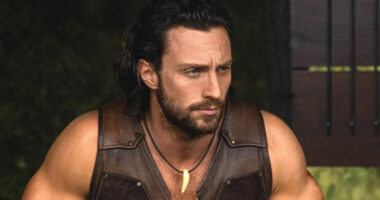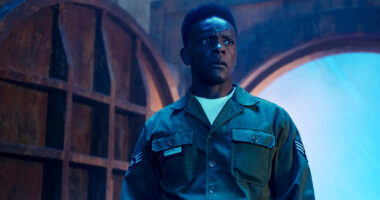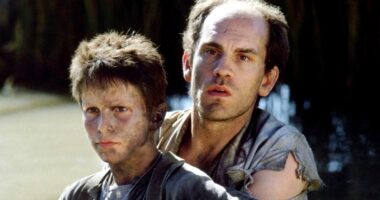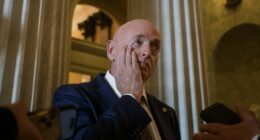Share this @internewscast.com
Saying goodbye is never easy. Whether it’s parting ways with a cherished person in reality or wrapping up a storyline with a beloved fictional figure, closing chapters can be challenging. This sentiment also holds true when an adored actor’s career unexpectedly concludes. While there are numerous actors whose deaths you may not be aware of, others are unforgettable due to their poignant final performances — performances that turned into their final goodbyes, ranging from comedic acts and memorable cameos to significant and profound portrayals.
There are countless actors whose final films have left a lasting impression for various reasons. Although listing every actor’s last appearance would be daunting, some stand out as particularly renowned and noteworthy. For some icons — considering their television roles — these may not be their ultimate performances. Yet, whether it’s Robin Williams, Paul Walker, Audrey Hepburn, Christopher Reeve, or Chadwick Boseman, these occasions represent the last time they graced the big screen in a major motion picture.
John Wayne in The Shootist
John Wayne was famed for being Hollywood’s quintessential western star over the decades. Known as The Duke, he shaped the image of the Western hero, one who faced challenges head-on. While many of his films from the 1970s seemed like a farewell tour, “The Shootist” stands out as his final work. This 1976 movie features Wayne as J.B. Books, a renowned lawman and gunfighter confronting his mortality due to cancer. A poignant detail is that Wayne himself was battling the same illness during its production.
Even though it’s well known that Wayne was quite demanding during filming, viewers at the time were likely unaware they were witnessing his final role. After “The Shootist” debuted in 1976, Wayne continued to live for a few more years until his passing on June 11, 1979. Watching “The Shootist” shows a man facing the inevitability of death onscreen and in real life, all while exemplifying the genre that made him legendary.
Quentin Tarantino captured it well in his review for New Beverly Cinema, noting that “There’s nothing in ‘The Shootist’ you haven’t seen done many times before and done better … But what you haven’t seen before is a dying John Wayne give his last performance.” It’s indeed an impressive sight.
James Dean in Giant
The untimely demise of James Dean is often considered one of Hollywood’s most devastating losses, casting a long-lasting shadow over the film industry. The rising star was just 24 when a car accident abruptly ended his promising future. After several television roles, Dean emerged as a film icon in 1955 by starring in a movie adaptation of John Steinbeck’s “East of Eden.” His next leading role, “Rebel Without a Cause,” came out posthumously, but his ultimate cinematic appearance surfaced a year later with the 1956 release of the epic “Giant.”
Known for being something of a diva, Dean wasn’t the first choice for the role of Jett Rink, but his unforgettable performance would earn him a second Academy Award nomination for best actor. It played to all of his strengths as an actor, as the melodrama of the West Texas oil business was the perfect backdrop for the Hollywood icon’s final performance. Although Dean died before filming was completed, he had finished his scenes in full. His absence for the remainder of filming didn’t sully the impact that “Giant” had upon its release. If anything, his death pushed the film further into the spotlight as a glimpse of the career that Dean may have had.
Chadwick Boseman in Ma Rainey’s Black Bottom
Best known for his portrayal of T’Challa/Black Panther in the Marvel Cinematic Universe, Chadwick Boseman had spent the final decade of his career diversifying his filmography and proving his exceptional skills as an actor. But few knew that, during that time, Boseman was diagnosed with colon cancer, which finally claimed his life in August 2020. Although Boseman’s final performance of any kind was voicing an alternate universe version of T’Challa in the animated Marvel series “What If…?,” his last live-action film role was in the Netflix production “Ma Rainey’s Black Bottom” — and boy does he give it his all.
Playing the charismatic trumpeter Levee Green, Boseman commands the screen in a career-defining performance that rivals even some of the star’s best roles. In one sequence in particular, considered one of Boseman’s most iconic scenes ever, Levee puts on quite a show, dancing and playing and proving his musical instincts to be far superior to that of his peers. As the Los Angeles Times wrote, “Boseman, evincing the same integrity he clung to his entire career, refuses to soft-pedal the destination.” While the Netflix film may not be what audiences most remember Boseman for, his work in “Ma Rainey’s Black Bottom” reveals the devotion of a man who loved to perform and did so to the very best of his ability.
Heath Ledger in The Imaginarium of Dr. Parnassus
Few actor deaths in the 21st century hit as hard for general audiences as that of Heath Ledger. Having become a household name with films like “10 Things I Hate About You,” “The Patriot,” and “Brokeback Mountain,” Ledger died in January 2008, seven months before the release of the most notable performance of his entire career, as the Joker in “The Dark Knight.” While the Clown Prince of Crime would define the rest of Ledger’s filmography (and perhaps rightfully so), it was not actually his final film.
That honor belongs to Terry Gilliam’s “The Imaginarium of Dr. Parnassus,” which hit theaters posthumously in late 2009. Although Ledger’s role as Tony Shepard would be completed by a combination of Johnny Depp, Jude Law, and Colin Farrell, the actor’s spirit hung over the entire production. While perhaps not as memorable as his work as the Joker, Ledger is as mysterious and complicated as ever here. The fate of his character eerily reflects Ledger’s own, and there’s something both melancholy and magical about it.
There’s a reason that it took three separate actors to complete Ledger’s work in the film. As Gilliam told Entertainment Weekly, Depp, Law, and Farrell were chosen because Ledger’s performance could not be matched by any one actor. “We’ll never know what the movie would’ve been like with Heath playing all of it,” the director explained, “but what we have is magical.”
Adrienne Shelly in Waitress
Lives and careers cut short are always a tragedy, but that word is especially applicable when the person in question has been murdered. This was the case with actress Adrienne Shelly, who was strangled to death in November 2006. Having become famous for her work in independent films like “Trust” and “The Unbelievable Truth,” not to mention “Sudden Manhattan” and “I’ll Take You There” (which she also wrote and directed), Shelly’s presence in the industry was on the rise. In fact, Shelly was killed just before the announcement that her newest motion picture, “Waitress,” had been accepted into the 2007 Sundance Film Festival.
Shelly wrote and directed the movie and also starred opposite Keri Russell as fellow waitress Dawn in the film. A comedy with plenty of heart that challenges one to take control of their circumstances and accept their lives as is, it offers a glimpse at the beauty that can be found in the mundane and is quite whimsical throughout. A true testament to Shelly’s talents as a storyteller, it’s perhaps all the more tragic that it marks the final on-screen appearance of a filmmaker who seemed like she was about to leave the sidelines of the movie industry at last.
Brandon Lee in The Crow
If you know anything about “The Crow,” then you’re likely already aware that the 1994 comic book adaptation was also the last film to feature Brandon Lee. The son of Bruce Lee (who suffered his own tragic fate two decades prior), Brandon Lee was nearing the end of his work on the movie when a mishap occurred with a prop gun on set. The weapon had not been properly checked, leading to Lee being shot with a real bullet and essentially bleeding to death. Although “The Crow” was finished after Lee’s passing, with future “John Wick” director Chad Stahelski filling in as a body double for the rest of his scenes, the accident hung over the film like the titular character himself, giving the movie a haunting quality.
In the film, after Lee’s character Eric Draven is shot and killed, he is resurrected a year later as “The Crow” to take vengeance on those responsible. In a similar vein, the posthumous release of Lee’s performance feels like a brief resurrection, only for the actor’s soul to be put to rest by the end credits. The parallels between Lee and his character are striking, both having left fiancées behind and both suffering gunshot wounds that led to their untimely demises. Lee’s performance in the film is outstanding, and it remains the only successful adaptation of “The Crow” to this day.
Robin Williams and Mickey Rooney in Night at the Museum: Secret of the Tomb
Robin Williams and Mickey Rooney are Hollywood legends due to their respective but different careers. The former was known as a comedic genius who could seamlessly glide between serious and humorous roles, while the latter was one of the few remaining stars from Hollywood’s silent era who spent nearly a century on the big screen. While quite dissimilar in style and overall reach, Williams and Rooney crossed paths on a few occasions, with their last on-screen performances both occurring in “Night at the Museum: Secret of the Tomb.”
The final installment of the “Night at the Museum” trilogy, “Secret of the Tomb” concludes the mythology of the films but also does much more than that. The film plays as a farewell to Williams, in particular, who uses his last moments on screen to inspire hope for the future and a last laugh to hold us over. “Smile, my boy, it’s sunrise,” he tells Ben Stiller’s character, and it’s enough to bring tears to the eyes of all watching. For an entire generation who grew up with Williams’ antics (and his version of Teddy Roosevelt), it’s a hard goodbye to sit through.
Likewise, though his role in the film is much smaller by comparison, Rooney’s last moments on screen as Gus are on brand for his overall career. It’s no wonder that the film was dedicated in their memory, as both actors died in 2014, and that it can be a difficult film for some fans to sit through.
Christopher Reeve in Rear Window
Best known for his role as Superman in four movies between 1978 and 1987, Christopher Reeve will forever be defined by the role. But in 1995, Reeve suffered a terrible accident that changed the course of the rest of his life and career. After a horse riding accident paralyzed Reeve from the neck down, it seemed unlikely that the actor would ever work again. However, Reeve proved everyone wrong by beating the odds and getting back in the figurative saddle. Three years after his accident, Reeve starred in a television remake of the Alfred Hitchcock classic “Rear Window.”
Reeve had a specific idea for what he hoped to accomplish with the movie. “I’d like to see more roles for disabled people where they’re cast in the lead instead of being the villain, or pathetic, or whatever,” he explained (via The Independent). “Just normal people.” Reeve, of course, played James Stewart’s role from the original (renamed Jason Kemp), and though the film itself is a bit mediocre, the star is not.
While Reeve would ultimately still be identified with his association with Superman — his final on-screen role was in an episode of the prequel series “Smallville,” followed by a director’s cut of the 1981 film “Superman II,” released posthumously in 2006 — his work in the 1998 version of “Rear Window” should not be ignored. Despite his physical challenges, Reeve was still at the top of his game.
Audrey Hepburn in Always
Few actresses who made a name for themselves during the Old Hollywood era of filmmaking were as downright delightful on the screen as Audrey Hepburn. Best known for classics like “Breakfast at Tiffany’s,” “Roman Holiday,” and “My Fair Lady,” Hepburn was one of the most recognizable actresses of her day — perhaps one of the most recognizable faces in the world. But after the late 1960s, Hepburn didn’t appear on the big screen nearly as often as audiences had become used to. With only a handful of film performances in the ’70s and ’80s, the icon’s final role was in 1989’s often-forgotten Steven Spielberg rom-com “Always.”
Playing an angel named Hap, who gives Richard Dreyfuss’ Pete Sandich advice on how to navigate his place in the afterlife, many consider Hepburn’s role in “Always” to be nothing more than a glorified cameo. In fact, we don’t even include it on our ranking of every Audrey Hepburn movie. But after filming her final big-screen role, Hepburn moved on to more important things. In the last few years of her life, she worked closely with UNICEF, going on several field missions as a Goodwill Ambassador until her death in January 1993.
Although Hepburn’s final role in “Always” may seem small in comparison to her philanthropic contributions, that she played an angel seeking to guide a weary soul just feels right considering the way she spent her final years. Hap was a beautiful last part for Hepburn to play, one that reflected the type of woman she aimed to be.
Marilyn Monroe and Clark Gable in The Misfits
When it comes to Old Hollywood, there are few names more iconic than Marilyn Monroe and Clark Gable. The two were each considered industry royalty, Monroe a timeless sex symbol and Gable the apparent “King of Hollywood.” So when these two big-screen powerhouses united for the 1961 picture “The Misfits,” it was a big deal. And considering that Gable passed away soon after production ended and Monroe mysteriously died not long after the film’s release, “The Misfits” was bound to be memorable, even if it only became so retroactively.
Gable plays longtime cowboy Gaylord Langland alongside Monroe’s Roslyn Taber, a recent divorcee who fancies the older man. While not your typical Hollywood Western, “The Misfits” presents Gable and Monroe as being, well, misfits in a larger world. Penned by Monroe’s ex-husband Arthur Miller, the film was considered a turning point in the film industry at the time, reflecting the changing landscape around these two stars. Little did they know how much it really would change following their respective deaths.
Philip Seymour Hoffman in The Hunger Games: Mockingjay
Once voted the “greatest actor of the 21st century” (via The Independent), Philip Seymour Hoffman was a powerful performer with a diverse career that ranged from big franchise blockbusters and auteur films to independent features and Oscar winners. Known for his distinct character roles, Hoffman’s final on-screen performance was in both parts of “The Hunger Games: Mockingjay” as the secret rebel Plutarch Heavensbee. Off-screen, Hoffman struggled in secret with substance abuse, which ultimately led to his death in February 2014.
Still, for a generation of young viewers, Hoffman was the face of the Hunger Games, as well as the secret rebellion brewing beneath. Hoffman almost finished his work on set before his untimely death, which ultimately changed what would have been his final scene with Jennifer Lawrence’s Katniss Everdeen. Although Hoffman may be best known for some of his other roles, “Mockingjay” was a two-part sendoff for the actor, with a performance highly praised by critics. Even at the end of his life, Hoffman was always a standout.
If you or anyone you know needs help with addiction issues, help is available. Visit the Substance Abuse and Mental Health Services Administration website or contact SAMHSA’s National Helpline at 1-800-662-HELP (4357).
Paul Walker in Furious 7
Aside from Vin Diesel, no face is more synonymous with the “Fast and Furious” franchise than Paul Walker’s. Though he was known for more than just car movies, Walker’s claim to fame stemmed from 2001’s original “The Fast and the Furious,” which spawned a whole saga of heist films and copycats. It was quite a blow, then, when Walker was killed in a 2013 car crash in Santa Clarita, California at the age of 40. Walker used the last months of his life to raise funds for those affected by Typhoon Haiyan and had just left a charity event when the accident occurred. He was also in the middle of shooting “Furious 7,” which would be the actor’s final on-screen role.
In general, “Furious 7” feels like the natural end of the “Fast and Furious” franchise. Though the series would continue after Walker’s death, the seventh installment is the culmination of all that came before, with Walker’s character, Brian O’Connor, officially retiring from “the life.” As much as the film stands on its own as an action-heist flick, it’s largely a tribute to Walker’s career and memory, with his brothers acting as character stand-ins to complete the movie. The film’s theme song, “See You Again” by Wiz Khalifa and Charlie Puth, cannot be played without conjuring memories of Walker, whose last performance feels like a definitive conclusion to his career.








